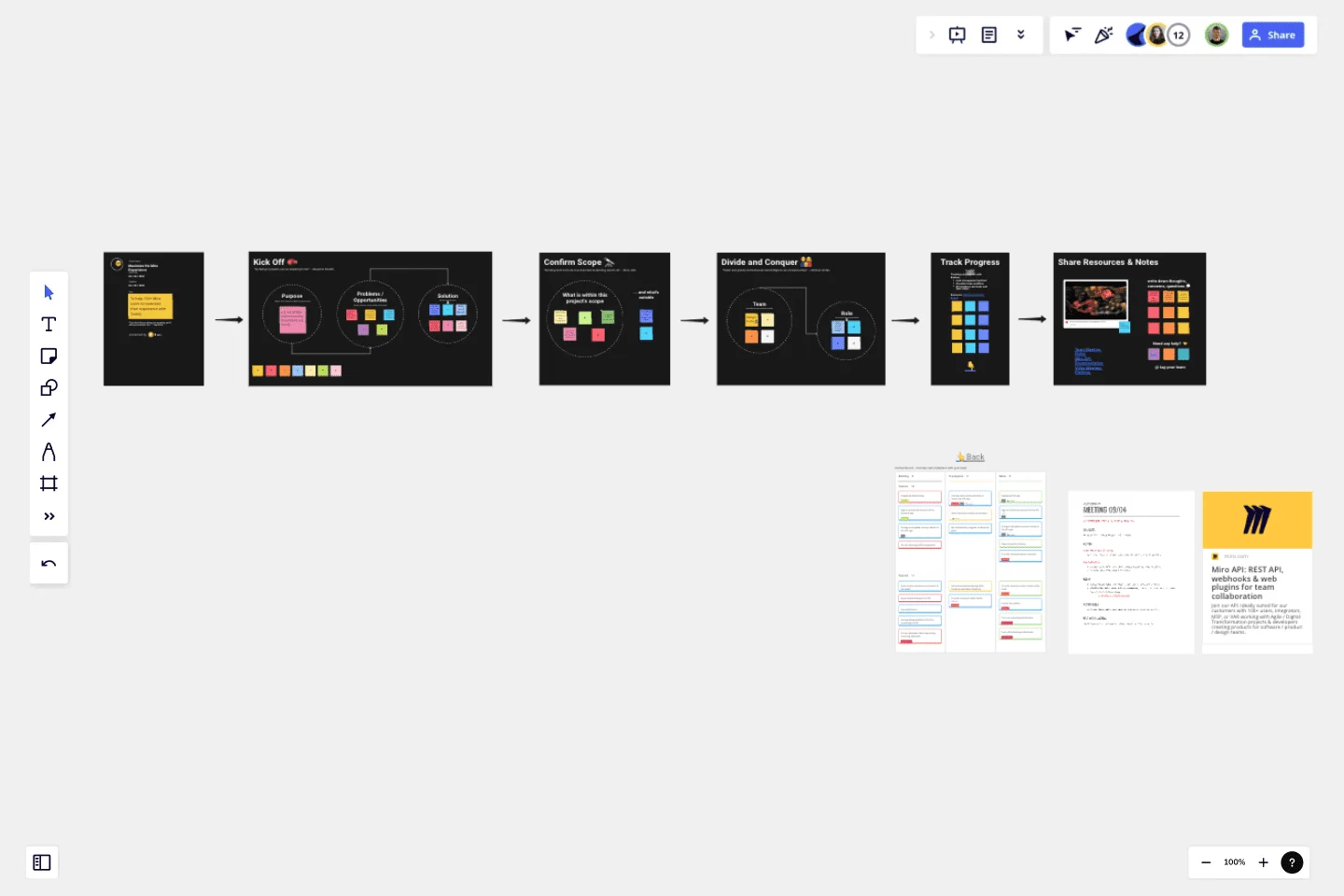Planning With Purpose
Set and achieve goals with the Planning With Purpose template. Align actions with objectives, prioritize tasks, and track progress.
"By failing to plan, you are preparing to fail".
Having a predictable and effective process is important to our team, so we created the “Planning With Purpose” template.
The template covers 5 key steps:
Kick-off
Manage scope
Divide and conquer
Track progress
Share resources & notes
Kick off a project by first communicating key project details, managing the project scope, letting each team member contribute in their key areas of expertise, using Miro’s kanban integration track progress, and share resources.
The best part -- all 5 steps can take place inside one Miro canvas, giving everyone a clear direction, visibility into task level details, and a handy place to meet virtually.
Use this planning template to start, track and execute a project with your team - no matter where they are located.
This template was creates by Toasty.
Get started with this template right now.
Kanban Successful Evolutionary Change
Works best for:
Kanban Boards, Agile Methodology, Agile Workflows
Kanban Successful Evolutionary Change template guides organizations through the process of implementing Kanban methodology for gradual and sustainable workflow improvement. By emphasizing incremental changes and continuous feedback, this template fosters a culture of continuous improvement and adaptability. Teams can visualize their workflow, identify bottlenecks, and implement changes iteratively, leading to improved efficiency and productivity.
Product Backlog Template
Works best for:
Agile Methodology, Kanban Boards, Product Management
Development teams are often juggling many products at once. A product backlog is a project management tool that helps teams keep track of projects in flight as they build and iterate, so you can store everyone's ideas, plan epics, and prioritize tasks. The highest-priority tasks are at the top of the product backlog, so your team knows what to work on first. Product backlogs make it easier for teams to plan and allocate resources, but it also provides a single source of truth for everyone to know what development teams are working on.
Change Canvas
Works best for:
Kanban Boards, Agile MEthodology, Agile Workflows
Change Canvas template empowers teams to manage and visualize change initiatives effectively. By mapping out stakeholders, goals, and actions, teams can ensure alignment and transparency throughout the change process. This template fosters collaboration and communication, enabling teams to navigate change successfully and achieve desired outcomes while minimizing disruption and resistance.
Prototype Template
Works best for:
UX Design, Design Thinking
A prototype is a live mockup of your product that defines the product’s structure, user flow, and navigational details (such as buttons and menus) without committing to final details like visual design. Prototyping allows you to simulate how a user might experience your product or service, map out user contexts and task flows, create scenarios to understand personas, and collect feedback on your product. Using a prototype helps you save money by locating roadblocks early in the process. Prototypes can vary, but they generally contain a series of screens or artboards connected by arrows or links.
Production Workflow Template
Works best for:
Agile Workflows, Agile Methodology, Project Management
Whether you’re producing a podcast, a marketing campaign, a TV show, or a piece of content, establishing a production workflow is crucial. A production workflow creates a visual guide to the different steps in a process. It can be used to train new team members or give a high-level overview to stakeholders. Although production workflows vary by team and business, they generally contain information about who the stakeholders are, how you brainstorm ideas, what your timeline looks like, and what resources you need to succeed.
Work Breakdown Structure Template
Works best for:
Project Management, Mapping, Workflows
A work breakdown is a project management tool that lays out everything you must accomplish to complete a project. It organizes these tasks into multiple levels and displays each element graphically. Creating a work breakdown is a deliverable-based approach, meaning you’ll end up with a detailed project plan of the deliverables you must create to finish the job. Create a Work Breakdown Structure when you need to deconstruct your team's work into smaller, well-defined elements to make it more manageable.
